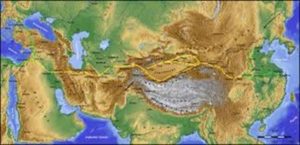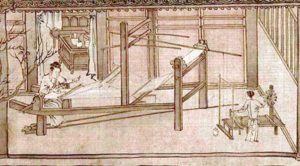The Silk Road
Cathy M Koos
What material things do you hold in high esteem? What possessions do you value? What specialty items do you desire?
Way back to prehistoric times, humans have desired and valued things from far away. Silk, spices, precious gems and metals, even lowly salt traveled along arduous, dangerous trade routes from producer to buyer — by camel, boat, even on foot. The Poet’s Road in Japan spawned some rather… clever… haiku. Salt, once considered white gold still travels by camel on the Salt Road from the Sahara Desert to Timbuktu.
Today acquiring precious goods like silk is as simple as hopping online and scrolling through hundreds of vendors or jumping in your car and visiting the nearest yarn or fabric store. Although in these days of Covid, it’s best to check individual stores for hours or if they are even open. Some have closed their storefronts and conducting only online business. But it is still easier than a several thousand mile camel journey.
Before the world had the World Wide Web, a different sort of network stretched from Xi’An, China 6000 dangerous miles to Istanbul, Turkey. Started around 130 BCE, a network of trade routes connected China with India, Uzbekistan, Turkmenistan, and Iran with Istanbul and Europe in the west. The average caravan took 240 days to travel the road and consisted of hundreds of camels and their stalwart drivers.

(Wikipedia)
By the middle of the 15th century, ships and navigation had improved so much that maritime routes made this lucrative trade more feasible and economical.
What commodities traveled back and forth? Silk from China graced the Pope’s Vatican for the first time and gold, cotton, linen and silver were sent back in return. Europe learned to enjoy exotic teas in fragile porcelain cups, thanks to the Silk Road. New spices graced the tables of southern Europe, such as sandalwood from India; saffron, nuts and dates from Persia; myrrh and frankincense from Somalia; and fancy glass from Samarkand.
Ideas and culture also traveled this network, sharing technology like the crossbow and gunpowder, and ideas like philosophy and religion. When British colonists settled in the American colonies, they planted vast numbers of mulberries and tried to produce silk in order to compete with the Chinese market, but even in the southern colonies efforts failed.

Liang Kai; Cleveland Museum of Art
Today, vestiges of the Silk Road still exist, and intrepid adventurers can walk the entire 6000 miles, or hop on a camel and purchase your silk in a colorful open-stall market. And we can also buy our silk on the worldwide web. So many choices.
But what started it all was a wonderful textile called silk and the Great Silk Road.
Click Here for next page